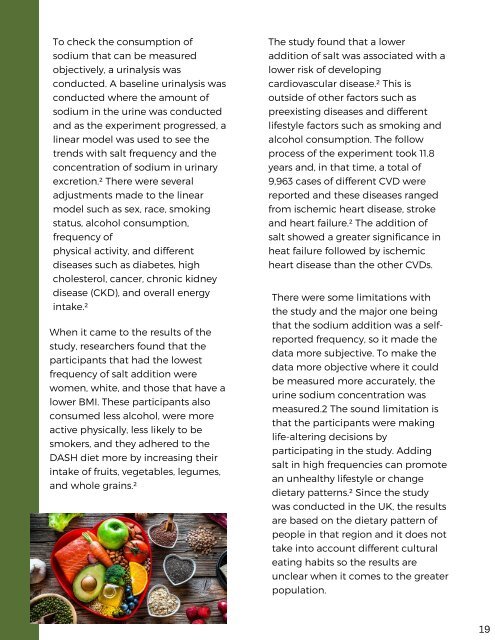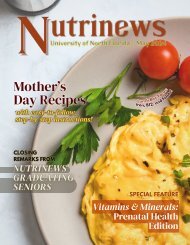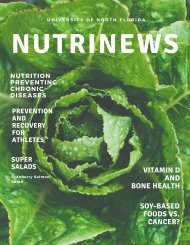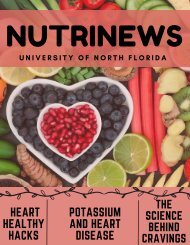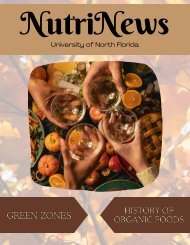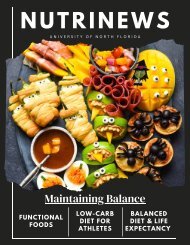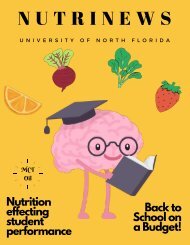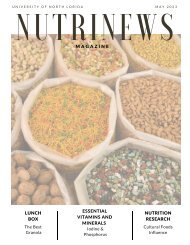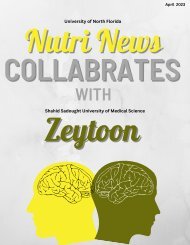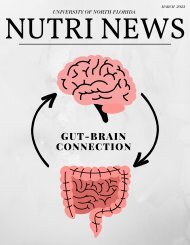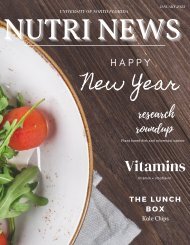Nutri News February 2023
This month theme is Heart Health!!! You will find articles about: • Since this month theme is heart health our monthly hack brings you 9 easy things you can take at home to improve heart health!! • Do you want to eat more vegetables but don’t know how? Check out the lunch box article for a delicious veggie pot pie recipe that the entire family will love! • Are you looking to spice up your workout routine? Look no further, HIIT training is a heart-friendly cardio workout with a blend of aerobic exercise and strength training!!! Check page 25 for more info • Have you ever wondered what’s the difference between omega-3 and omega-6? Let’s talk fats! • Salt vs Sugar, who is the real culprit? Find out the truth in page 15! • If you go to the gym or partake in any physical related activities you might have heard or use pre-workout to get that extra pump of energy, but have you ever stopped to think about the actual mechanism of pre-workout? Go check page 6 for the pros and cons of pre-workout you might learn a thing or two!! • Calcium is a mineral mainly associated with bone and teeth health, but did you know that calcium plays a very important function in heart health? Check out our essential guide to vitamins and minerals article to learn more!! This month’s student spotlight is Lyla Palompo, check what she has to say in page 21! If you are looking to make an impact on campus as well as in the community, look for the fliers highlighting volunteer opportunities. These amazing programs are always looking for more volunteers. It is amazing the difference we can make when we all work together for a better and healthier tomorrow. Happy reading!
This month theme is Heart Health!!!
You will find articles about:
• Since this month theme is heart health our monthly hack brings you 9 easy things you can take at home to improve heart health!!
• Do you want to eat more vegetables but don’t know how? Check out the lunch box article for a delicious veggie pot pie recipe that the entire family will love!
• Are you looking to spice up your workout routine? Look no further, HIIT training is a heart-friendly cardio workout with a blend of aerobic exercise and strength training!!! Check page 25 for more info
• Have you ever wondered what’s the difference between omega-3 and omega-6? Let’s talk fats!
• Salt vs Sugar, who is the real culprit? Find out the truth in page 15!
• If you go to the gym or partake in any physical related activities you might have heard or use pre-workout to get that extra pump of energy, but have you ever stopped to think about the actual mechanism of pre-workout? Go check page 6 for the pros and cons of pre-workout you might learn a thing or two!!
• Calcium is a mineral mainly associated with bone and teeth health, but did you know that calcium plays a very important function in heart health? Check out our essential guide to vitamins and minerals article to learn more!!
This month’s student spotlight is Lyla Palompo, check what she has to say in page 21!
If you are looking to make an impact on campus as well as in the community, look for the fliers highlighting volunteer opportunities. These amazing programs are always looking for more volunteers. It is amazing the difference we can make when we all work together for a better and healthier tomorrow.
Happy reading!
You also want an ePaper? Increase the reach of your titles
YUMPU automatically turns print PDFs into web optimized ePapers that Google loves.
To check the consumption of<br />
sodium that can be measured<br />
objectively, a urinalysis was<br />
conducted. A baseline urinalysis was<br />
conducted where the amount of<br />
sodium in the urine was conducted<br />
and as the experiment progressed, a<br />
linear model was used to see the<br />
trends with salt frequency and the<br />
concentration of sodium in urinary<br />
excretion.² There were several<br />
adjustments made to the linear<br />
model such as sex, race, smoking<br />
status, alcohol consumption,<br />
frequency of<br />
physical activity, and different<br />
diseases such as diabetes, high<br />
cholesterol, cancer, chronic kidney<br />
disease (CKD), and overall energy<br />
intake.²<br />
When it came to the results of the<br />
study, researchers found that the<br />
participants that had the lowest<br />
frequency of salt addition were<br />
women, white, and those that have a<br />
lower BMI. These participants also<br />
consumed less alcohol, were more<br />
active physically, less likely to be<br />
smokers, and they adhered to the<br />
DASH diet more by increasing their<br />
intake of fruits, vegetables, legumes,<br />
and whole grains.²<br />
The study found that a lower<br />
addition of salt was associated with a<br />
lower risk of developing<br />
cardiovascular disease.² This is<br />
outside of other factors such as<br />
preexisting diseases and different<br />
lifestyle factors such as smoking and<br />
alcohol consumption. The follow<br />
process of the experiment took 11.8<br />
years and, in that time, a total of<br />
9,963 cases of different CVD were<br />
reported and these diseases ranged<br />
from ischemic heart disease, stroke<br />
and heart failure.² The addition of<br />
salt showed a greater significance in<br />
heat failure followed by ischemic<br />
heart disease than the other CVDs.<br />
There were some limitations with<br />
the study and the major one being<br />
that the sodium addition was a selfreported<br />
frequency, so it made the<br />
data more subjective. To make the<br />
data more objective where it could<br />
be measured more accurately, the<br />
urine sodium concentration was<br />
measured.2 The sound limitation is<br />
that the participants were making<br />
life-altering decisions by<br />
participating in the study. Adding<br />
salt in high frequencies can promote<br />
an unhealthy lifestyle or change<br />
dietary patterns.² Since the study<br />
was conducted in the UK, the results<br />
are based on the dietary pattern of<br />
people in that region and it does not<br />
take into account different cultural<br />
eating habits so the results are<br />
unclear when it comes to the greater<br />
population.<br />
19


